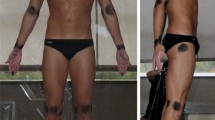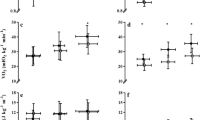Abstract
The purpose of this study was to examine the effect of passive underwater torque on active body angle with the horizontal during front crawl swimming and to assess the effect of body size on passive torque and active body angle. Additionally, the effects of passive torque, body angle and hydrostatic lift on maximal sprinting performance were addressed. Ten boys [aged 11.7 (0.8) years] and 12 male adult [aged 21.4 (3.7) years] swimmers volunteered to participate. Their body angle with the horizontal was measured at maximal velocity, and at two submaximal velocities using an underwater video camera system. Passive torque and hydrostatic lift were measured during an underwater weighing procedure, and the center of mass and center of volume were determined. The results showed that passive torque correlated significantly with the body angle at a velocity 63% of vmax (α63 r=−0.57), and that size-normalized passive torque correlated significantly with the α63 and α77 (77% of vmax) with r=−0.59 and r=−0.54 respectively. Hydrostatic lift correlated with α63 with r=−0.45. The negative correlation coefficients are suggested to be due to the adults having learned to overcome passive torque when swimming at submaximal velocities by correcting their body angle. It is concluded that at higher velocities the passive torque and hydrostatic lift do not influence body angle during swimming. At a velocity of 63% of vmax, hydrostatic lift and passive torque influences body angle. Passive torque and size-normalized passive torque increases with body size. When corrected for body size, hydrostatic lift and passive torque did not influence the maximal sprinting velocity.

Similar content being viewed by others
References
Brooks RW, Lane CC, Sawhill JA (2000) The biomechanical interaction of lift and propulsion forces during swimming. Med Sci Sports Exerc [Suppl] 32:910
Capelli C, Zamparo P, Cigalotto A, Francescato MP, Soule RG, Termin B, Pendergast DR, di Prampero PE (1995) Bioenergetics and biomechanics of front crawl swimming. J Appl Physiol 78:674–679
Chatard JC, Collomp C, Maglischo E, Maglischo C (1990) Swimming skill and stroking characteristics of front crawl swimmers. Int J Sports Med 11:156–161
Chatard JC, Senegas X, Selles M, Dreanot P, Geyssant A (1995) Wet suit effect, a comparison between competitive swimmers and triathletes. Med Sci Sports Exerc 27:580–586
Chollet D, Chalies S, Chatard JC (2000) A new index of coordination for the crawl: description and usefulness. Int J Sports Med 21:54–59
Colman V, Persyn U, Daly D, Stijnen V (1998) A comparison of the intra-cyclic velocity variation in breaststroke swimmers with flat and undulating styles. J Sports Sci 16:653–665
Cordain L, Kopriva R (1991) Wetsuits, body density, and swimming performance. Br J Sports Med 25:31–33
Cureton ThK (1933) Natural and artificial buoyancy, flotation and body balance in the water. Beach Pool 7:272, 282–287
Cureton ThK (1951) Physical fitness of champion athletes. University of Illinois Press, Urbana
De Groot G, van Ingen Schenau GJ (1988) Fundamental mechanics applied to swimming: technique and propelling efficiency. In: Ungerechts B, Wilke K, Reischle K (eds) Swimming science V. Human Kinetics, Champaign, pp 17–29
Holmér I (1974) Energy cost of arm stroke, leg kick and the whole stroke in competitive swimming styles. Eur J Appl Physiol 33:105–118
Larsen OW, Yancher RP, Baer C (1981) Boat design and swimming performance. Swimming Tech 18:38–44
McLean SP, Hinrichs RN (1998) Sex differences in the centre of buoyancy location of competitive swimmers. J Sports Sci 16:373–383
McLean SP, Hinrichs RN (2000) Buoyancy, gender, and swimming performance. J Appl Biomech 16:248–263
Parsons L, Day SJ (1986) Do wet suits affect swimming speed? Br J Sports Med 20:129–131
Pendergast DR, di Prampero PE, Craig AB, Wilson DR, Rennie DW (1977) Quantitative analysis of the front crawl in men and women. J Appl Physiol 43:475–479
Rennie DW, Pendergast DR, di Prampero PE (1975) Energetics of swimming in man. In: Lewillie L, Clarys JP (eds) Swimming II. University Park Press, Baltimore, pp 97–104
Shapiro R, Blow C, Rash G (1987) Video digitizing analysis system. Int J Sports Biomech 3:80–86
Toussaint HM, Beek PJ (1992) Biomechanics of competitive front crawl swimming. Sports Med 13:8–24
Toussaint HM, Bruinink L, Coster R, de Looze M, van Rossem B, van Veenen R, De Groot G (1989) Effect of a triathlon wet suit on drag during swimming. Med Sci Sports Exerc 21:325–328
Vorontsov AR, Rumyantsev VA (2000) Resistive forces in swimming. In: Zatsiorsky VM (ed) Biomechanics in sport: performance enhancement and injury prevention. Blackwell, Oxford, pp 184–204
Yanai T (2001) Rotational effect of buoyancy in frontcrawl: does it really cause the legs to sink? J Biomech 34:235–243
Zamparo P, Antonutto G, Capelli C, Francescato MP, Girardis M, Sangoi R, Soule RG, Pendergast DR (1996a) Effects of body size, body density, gender and growth on underwater torque. Scand J Med Sci Sports 6:273–280
Zamparo P, Capelli C, Termin B, Pendergast DR, di Prampero PE (1996b) Effects of underwater torque on the energy cost, drag and efficiency of front crawl swimming. Eur J Appl Physiol 73:195–201
Acknowledgements
We appreciate the help of Mrs Calisa Schouweiler and Mr Ole Fjørtoft with data collection. Prof. Gerald Smith and Associate Prof. Svein Linge are thanked for their careful reviews of the manuscript. Finally, all the swimmers and their coaches are thanked for their participation in this study.
Author information
Authors and Affiliations
Corresponding author
Rights and permissions
About this article
Cite this article
Kjendlie, PL., Stallman, R.K. & Stray-Gundersen, J. Passive and active floating torque during swimming. Eur J Appl Physiol 93, 75–81 (2004). https://doi.org/10.1007/s00421-004-1165-7
Accepted:
Published:
Issue Date:
DOI: https://doi.org/10.1007/s00421-004-1165-7




